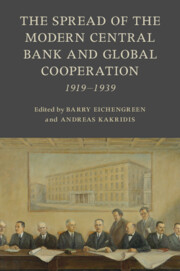Book contents
- The Spread of the Modern Central Bank and Global Cooperation
- Studies in Macroeconomic History
- The Spread of the Modern Central Bank and Global Cooperation
- Copyright page
- Contents
- Figures
- Tables
- Editors and Contributors
- Preface
- Part I General
- 1 Interwar Central Banks
- 2 The Ideology of Central Banking in the Interwar Years and Beyond
- 3 Habit Not Heredity
- 4 Institutionalizing Central Bank Cooperation
- Part II Specific
- Index
- References
1 - Interwar Central Banks
A Tour d’ Horizon
from Part I - General
Published online by Cambridge University Press: 02 November 2023
- The Spread of the Modern Central Bank and Global Cooperation
- Studies in Macroeconomic History
- The Spread of the Modern Central Bank and Global Cooperation
- Copyright page
- Contents
- Figures
- Tables
- Editors and Contributors
- Preface
- Part I General
- 1 Interwar Central Banks
- 2 The Ideology of Central Banking in the Interwar Years and Beyond
- 3 Habit Not Heredity
- 4 Institutionalizing Central Bank Cooperation
- Part II Specific
- Index
- References
Summary
This chapter is an overview of central banking developments between 1919 and 1939, highlighting the establishment and operation of 28 new central banks, most in what are now called emerging markets and developing countries. Inspired by expert advice and underpinned by foreign lending, the new banks were designed to function independently from political interference, and to defend the gold standard as part an international, rules-based network of cooperating institutions. The Great Depression revealed the flaws in this setup. As capital flows dried up and international cooperation faltered, the gold standard disintegrated, and central banks were unable to head off macroeconomic and financial collapse. Designed to fight inflation, they were ill-prepared to address financial fragility. In the wake of their failure, a two-pronged reaction set in. Central bank autonomy was curtailed, while monetary policy was subordinated to new policy objectives, including the support of import substitution in Latin America and central planning in Eastern Europe. At the same time, central banks’ powers expanded, as they were transformed into agents of state-led development policy. Thus, the new central banks of the 1920s and 1930s were integrally involved not just in post-First World War reconstruction and the Great Depression, but also in the key economic developments of the mid-20th century.
Keywords
Information
- Type
- Chapter
- Information
- The Spread of the Modern Central Bank and Global Cooperation1919–1939, pp. 3 - 39Publisher: Cambridge University PressPrint publication year: 2023
